Bursting with ancient treasures of Indo-Islamic architecture, otherworldly murals and a rocky river running through the town, Orchha is one to put at the top of the list. The name translates to ‘hidden place’ and is often overlooked due to the popularity of neighbouring Khajuraho, but it’s just as exciting as many of the surrounding ‘must see’ spots and a great way to engage with India’s history without the huge crowds.
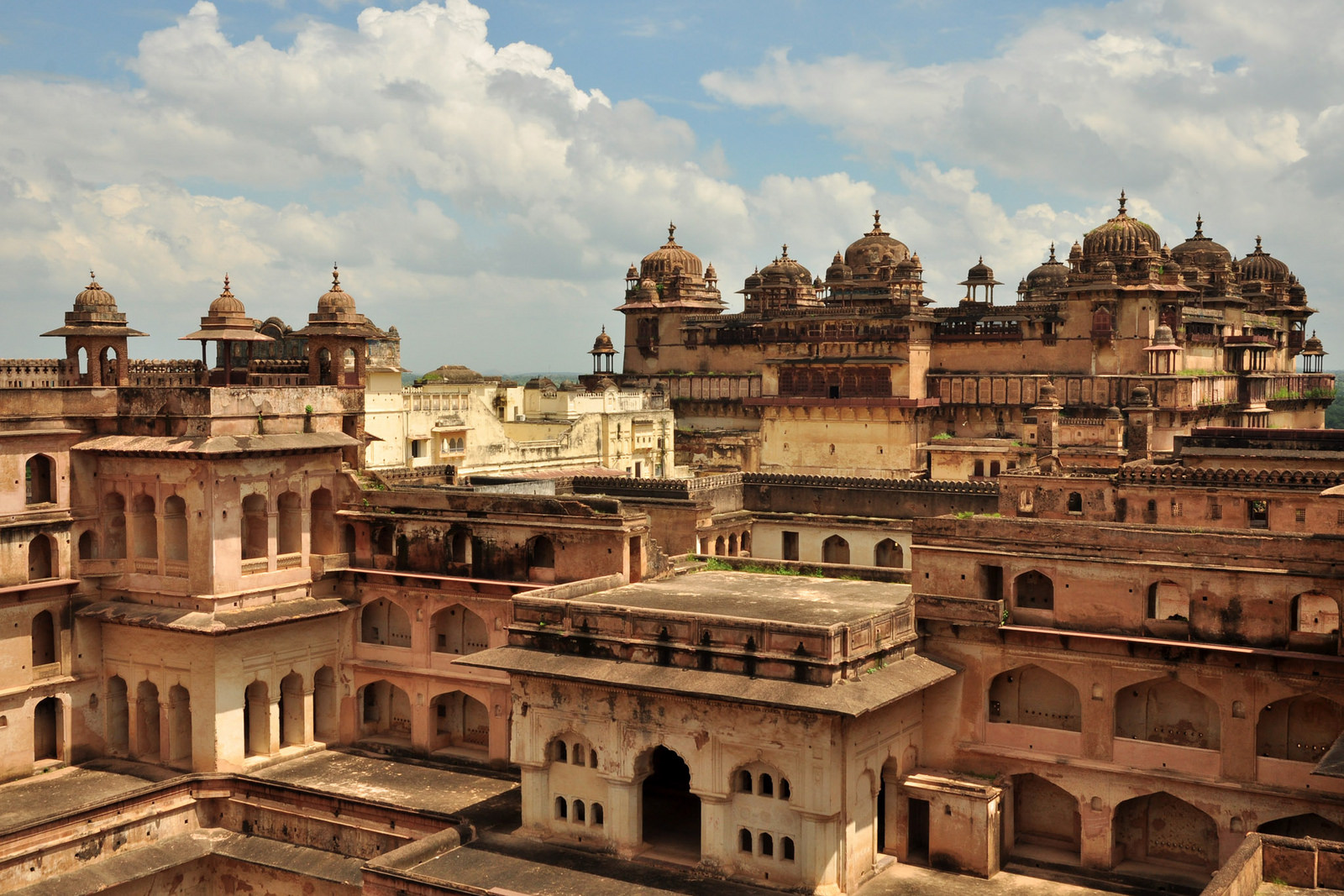
Jahangir Mahal (Photo: Bruno Vanbesien via Flickr)
On arrival, visitors will enter through the Ganesh Darwaja, the first gate to the kingdom which leads straight into the centre of the action. The Orchha Fort is the first stop. Commissioned by Vir Singh Bundela in the early 16th century it’s one of the cornerstone pieces of architecture in the town. Pass a sign that says ‘Protect your heritage and feel glorious’ and enter a garden where the trimmed flower beds are still intact and the pathways lead you around a geometric playground.
The walls of the fort have had less TLC over the years but the alcoves and arches still remain. Follow the stairs to find four hundred-year-old murals of elephants with five trunks, robed figures travelling on floating carpets and skies filled with stars. And on reaching the top, peak out at the view the Rajput dreamed of. He is long gone, so the only inhabitants to share this place with are a group of cows who lounge in the shade of the thick fort walls.
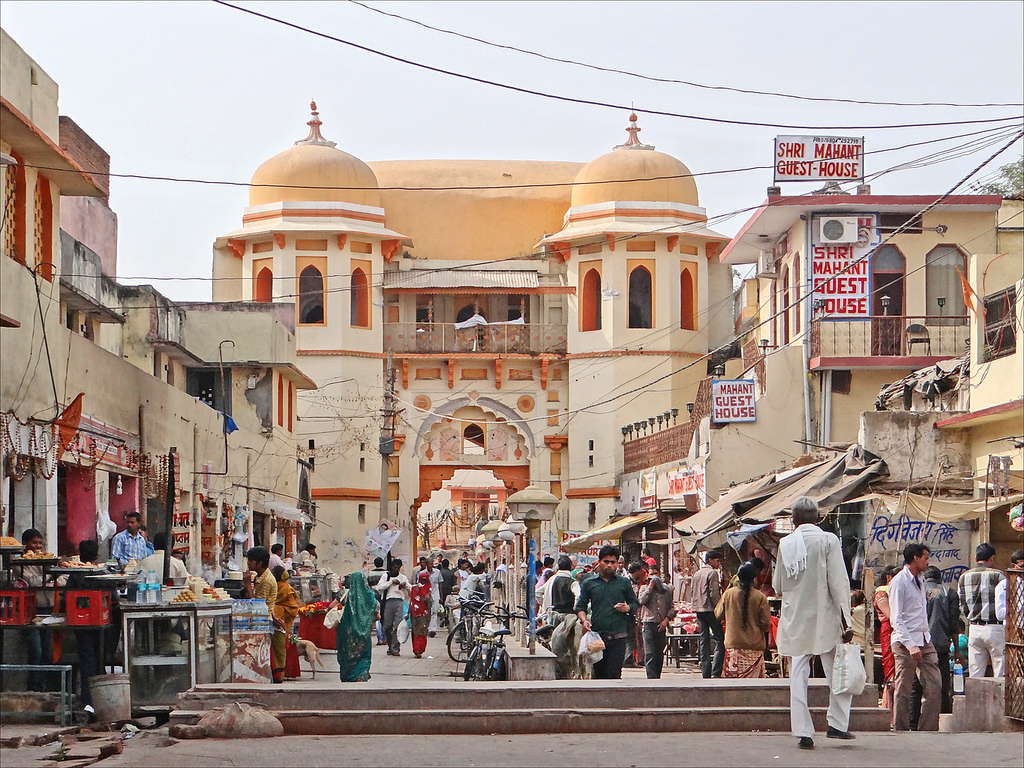
Entering the town (Photo: Jean Pierre Dalbéra via Flickr)
Jahangir Mahal ranks alongside the fort in the list of hot spots in Orchha. This is the Indo-Islamic jewel of architecture in the town and was built specifically to honour the life of Mughal ruler Jahangir by King Vir Singh Deo in the early 1600s. The stone is polished by the thousands of footsteps which have passed through here. Archways and corridors, passages and staircases that go on forever whirl you through a day in the life of a noble in 17th century India. Be sure not to miss the east side of the Palace which is covered in turquoise tiles.
Just behind the Jahangir Mahal are the Camel Stables but a question hangs over if they were really used to house large desert creatures. Some stories say that they would have been used as a pleasure pavilion by the Rajput, but for now they remain elusive. Either way, it’s not hard to imagine a time when dust would’ve been kicked up by camels instead of motorbikes, and the sound of hooves would’ve taken the space which revving engines fill today.
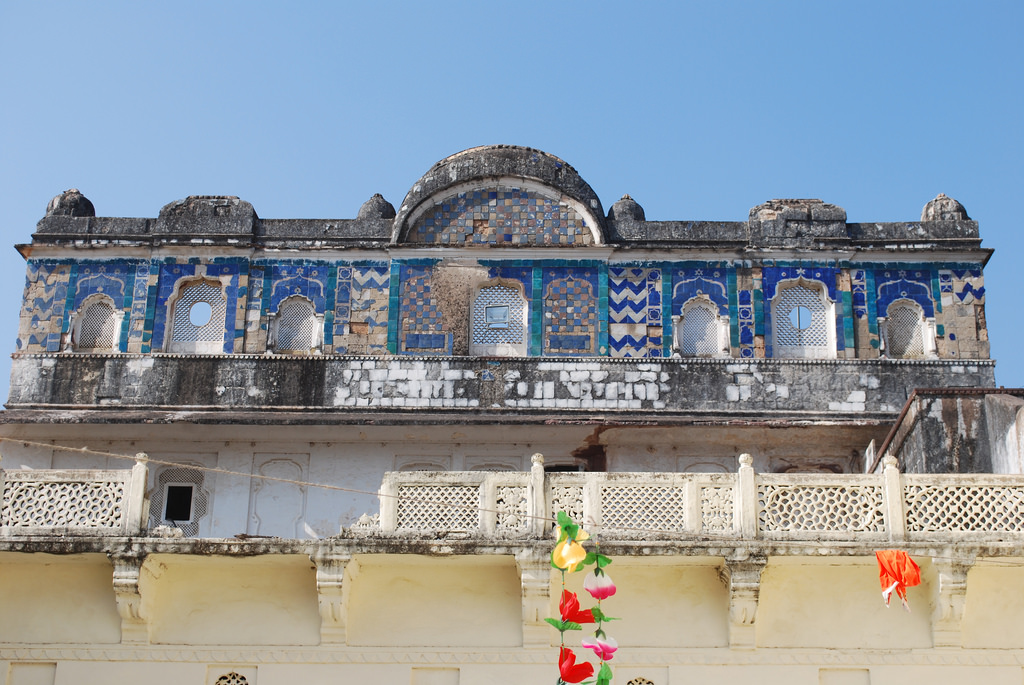
Blue tiles (Photo: Jeff Hart via Flickr)
Ram Raja is a particularly special temple as it is the only place in the whole of India where the God Rama is worshipped as king. Rama is the central character of the Ramayana, an important epic text in Hinduism which sees the hero cross the land to rescue his wife Sita from the demon king Ravana. Ram Raja Temple, also known as Orchha temple is a destination for pilgrims and throughout the year large festivals are held when large numbers of devotees come to visit the temple. Rama Navami happens in the spring time and celebrates Rama’s birthday so is one to watch out for if visiting in March/April.
Chaturbhuj Temple was founded in 1554 by Maharaja Madhukar Shah and was due to have an idol of Rama installed inside. However, plans didn’t go ahead due to a Mughal invasion. Rujpat Vir Singh Bundela completed the building of the temple and the Queen installed the deity in her own Palace. Built from bricks and lime it is a central example of architecture of the Bundela period.
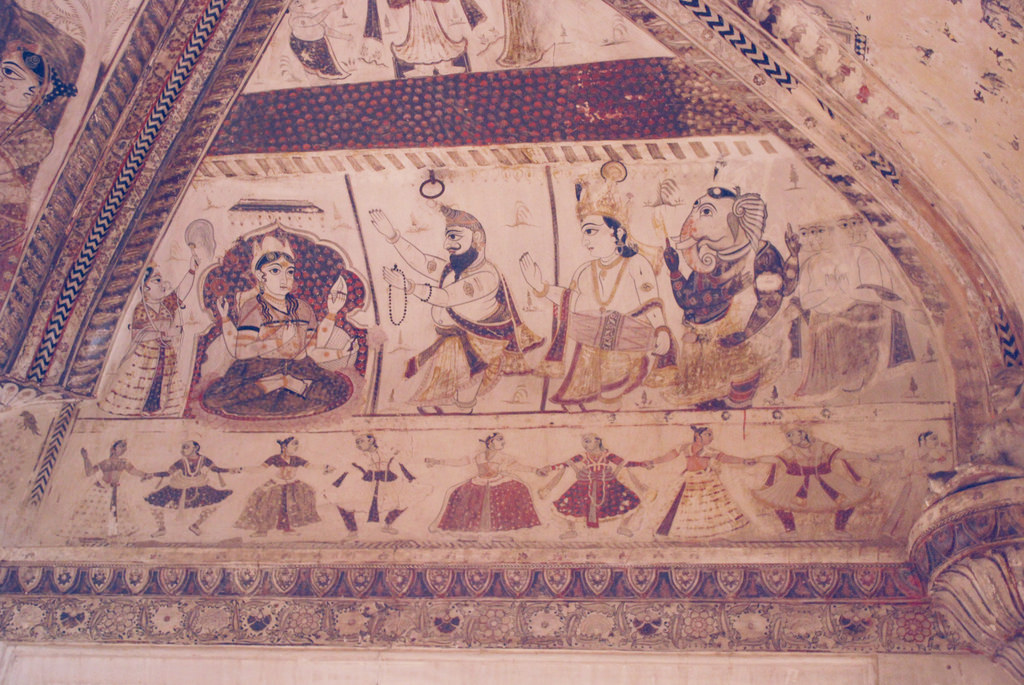
Laxmi Temple paintings (Photo: Jeff Hart via Flickr)
Another unmissable part of any trip to Orchha is a visit to Laksmi Narayan. Not quite a temple, fort, or a palace, it’s an almost mythical place. The top is modelled from the same design as a Portuguese dome and much of the rest of the building is inspired by Indo-Persian design. It was built around 1662 by Rajput Vir Singh. Make sure you look up, for the murals on the ceiling are trippy visions of mythical creatures and animals painted with eyelash sized brushes, every detail taken care of, every colour included. These images honour the richness of India’s artistic history and culture and it is one of the best places to let the mind wander and tick over how things have changed in the five hundred years since the bricks were stacked in this town.
Food and Drink
The smells of ginger, cinnamon, cardamom and coriander waft down the street at all times of day. Follow your nose to one of the many thali cafes and chai tea sellers if you’re looking for some authentic Madhya Pradesh chow to fuel you through the day. There is little meat served here and alcohol is forbidden in so it’s worth arriving prepared if these are things that you’ll miss.
The Grace of India (Jhansi Road) is a family run place where you could happily eat for breakfast, lunch and dinner and not get bored of the options on the menu. If you take an interest in the cooking they might even show you some of their tricks and tips. The food is all cooked fresh here and there is a great temple view if you sit on the roof.
Orchha hut (Jhansi road) is easy to find and a good place for lunch as it’s next to Laxmi Narayan and Ram Raja. It’s known in town for the chef and owner, Mr Ranu who is something of a local hero, serving up fresh food and running the show virtually single-handedly. Ask for his recommendation because the best food comes from the seasonal ingredients which vary depending on what time of year you are there. Make sure not to miss out on his extra gingery chai which will put fire in the belly for an afternoon of wandering.
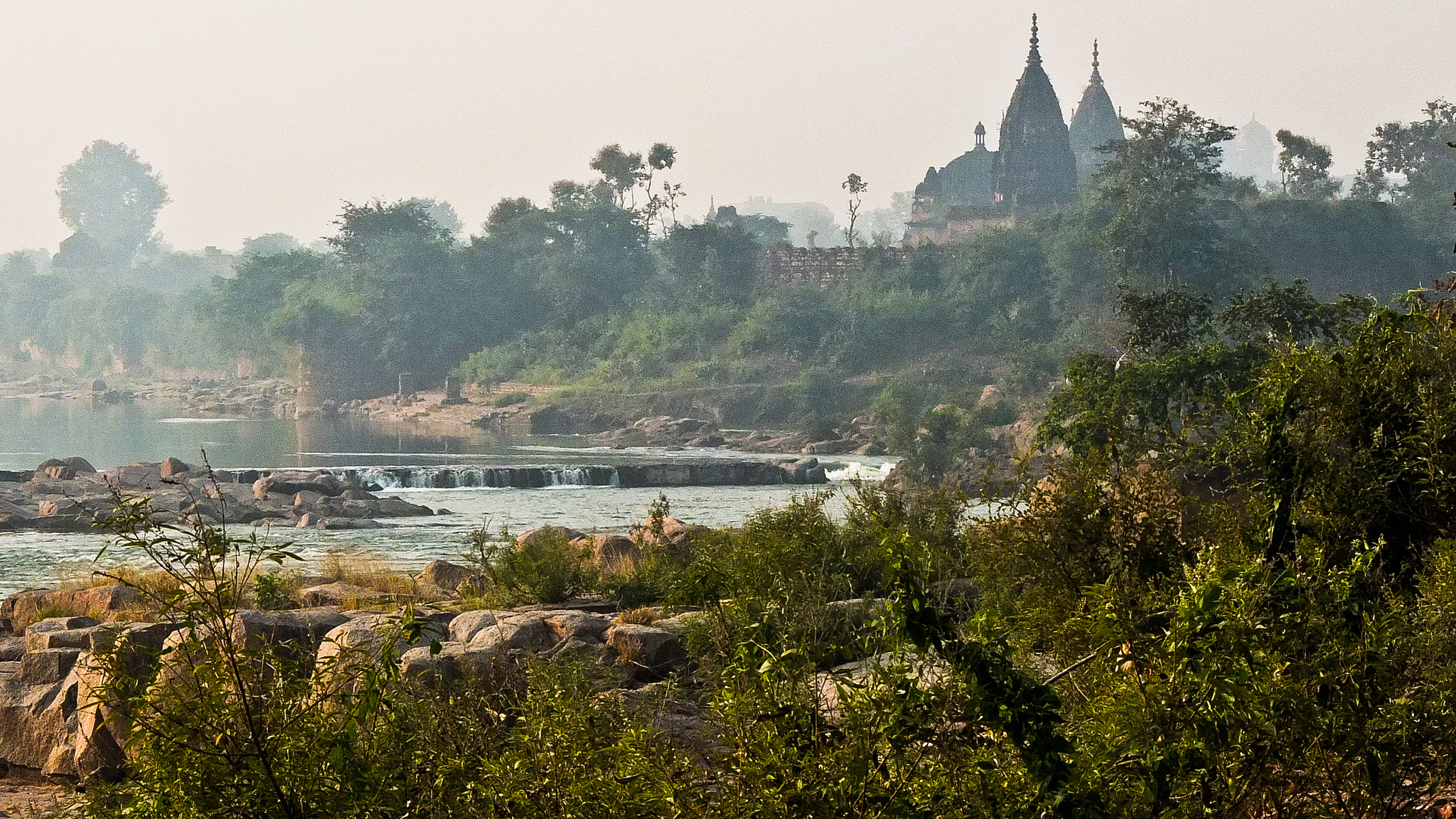
River Betwa and Chattris (Photo: Daniel Perries via Flickr)
Bhola Restaurant (Sheesh Mahal Road, Corner Jehangir Mahal Tikamgarh road) Near the Jahangir Mahal is also a good lunch time spot. They serve up delicious dosas and uttapams and it’s the perfect place to grab a lassi in the heat of the day. The thalis are big so perfect for sharing if in a group.
Mediterraneo (Front of Bus Stand, River road) has a menu packed with comfort food. Curry is of course top of the list, closely followed by Pizza, pasta and pancakes (the latter are recommended for breakfast). Look up to find it as it’s on the first floor above a junk shop. It’s one of the most well-kept restaurants in town, both clean and comfortable and you’ll find plenty of locals eating here too which is always a good sign.
Accommodation & Hotels
Temple View Guest House (Behind Ramraja Temple) is a family run guest house which is great value, cosy and a hit with backpackers for the free chai and free samosas available to all. The price includes comfortable beds, big windows, air conditioning and a roof top to hang out on. The major sights are all within walking distance and it’s rated one of the safest places to stay in town.
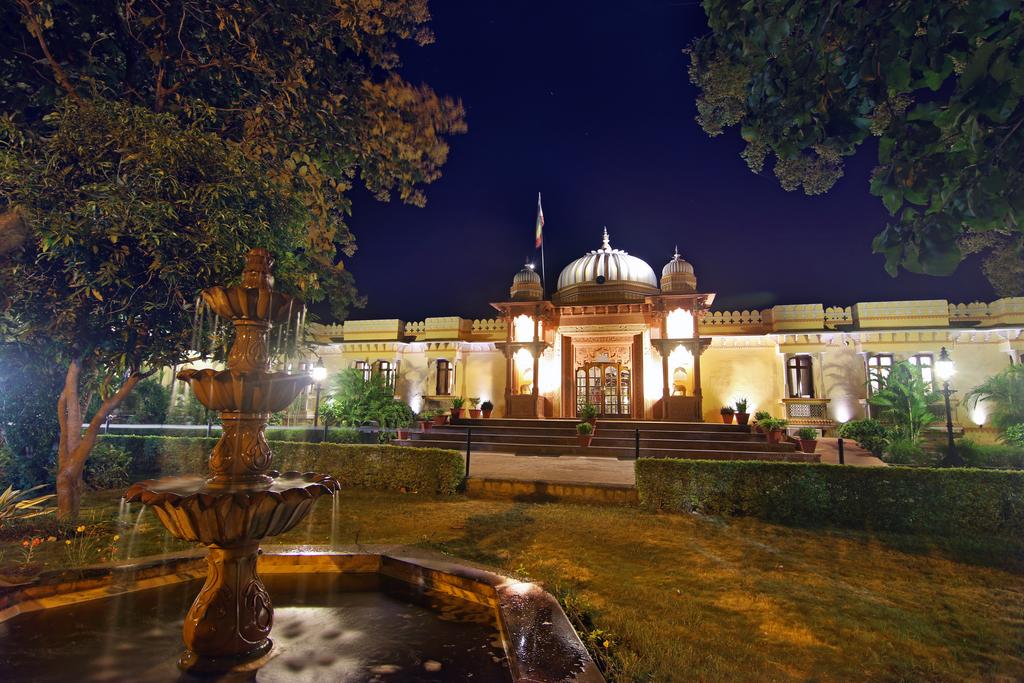
Amar Mahal at night (Photo: Amar Mahal Hotel)
Amar Mahal (Bypass rd.) offers an outdoor pool, a massage parlour, and a spa and wellness centre. The rooms are clustered around a grassy courtyard and breakfast is served outside in the sun every morning. Each room is air conditioned and has a minibar and sofa, and many of the rooms have four poster beds and hand painted walls. There is 24-hour room service and a restaurant open for breakfast, lunch and dinner.
A step into luxury accommodation is the New Laxmi Temple View (near Laxmi Temple Road). It’s a little distance from the main attractions but more peaceful as a result. Everything still feels new as it is only a few years old and it’s been well looked after so is clean and clear of dust. The staff are exceptionally friendly and treat guests as family so it’s an instantly welcoming place to land for a night in Orchha. There’s free tea here too.
Hotel Sunset (near Laxmi Temple Road, behind Ramaraja Temple) is a good spot for couples to stay. The clue is in the name it seems, and there are good views of the sunset from the rooftop here. Sunsets over the city make the place feel timeless and when the sun has folded in for the night visitors can do the same here in equally comfortable beds. Most rooms have private bathrooms, and some have TVs.
Orchha on the Water
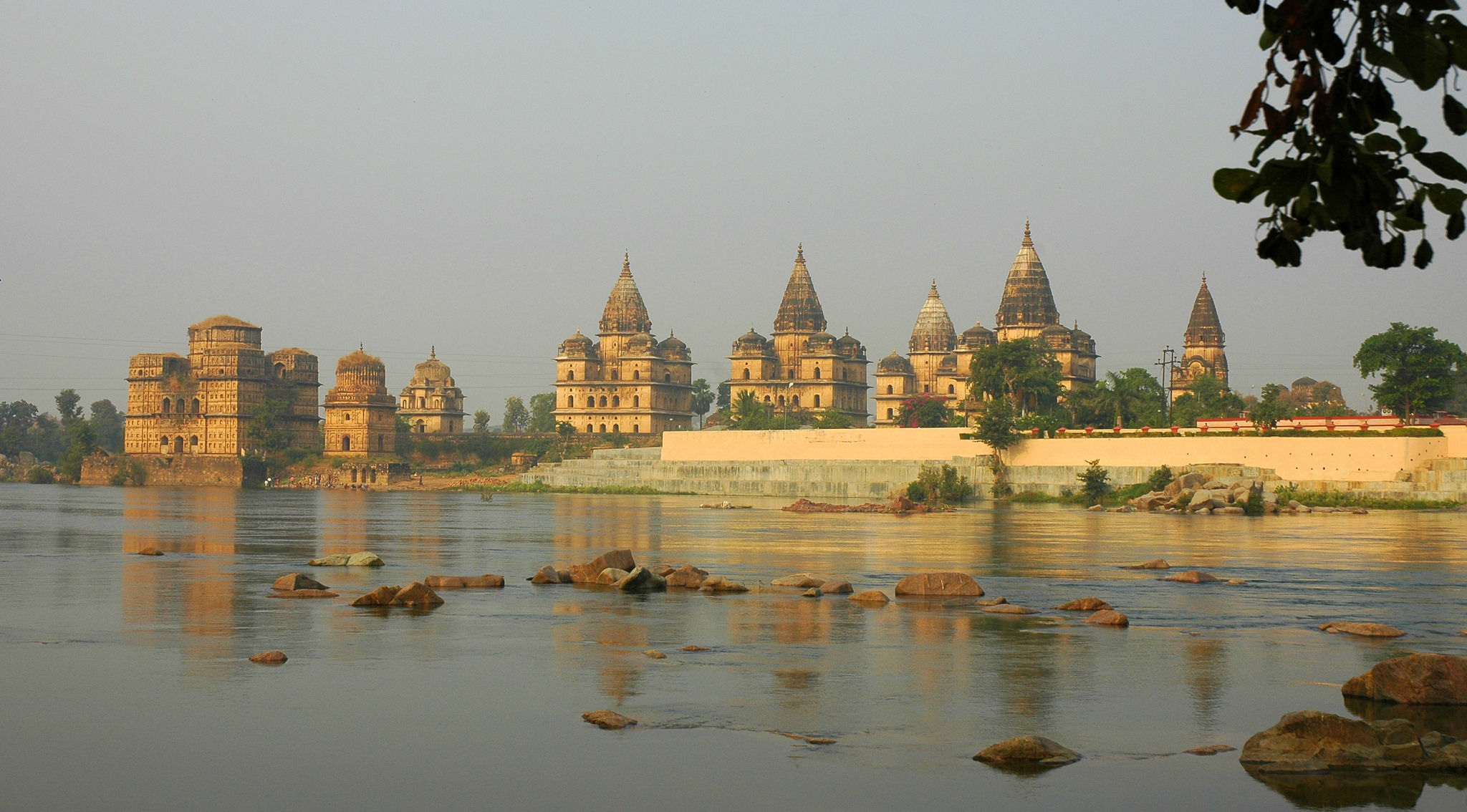
Orchha from the water (Photo: Prashant Ram via Flickr)
No trip to Orchha would be complete without a wander down the river. The Chattris that line the water are burial grounds of nobles, and visitors can meander along paths lined with fluorescent fuchsia flowers, admiring these architectural features along the way. Make sure to check out the domes inside and outside for more murals and paintings. One of the best ways to absorb the beauty of the Chhatris is to view them from the other side of the river or from a boat.
If being on the water sounds good to you, head to the Orchha boat club where you can rent boats and raft down the Betwa. The river is wide and the waters break into Grade I and Grade II rapids so it’s not just a lazy float down-stream the entire time. It’s a great way to raise your heart rate and get refreshed during a hot and sticky day in Orchha.
Other reliable places which provide boats are luxury hotels in town such as Betwa Mahal (Rajaram temple road) and Sheesh Mahal (Jahangir Mahal). They will also give you advice on the best times to go onto the water and give safety advice. If travelling in monsoon season the river will be too high for boats to go down the water so bear this in mind when planning a trip.
And finally, a dive into the waters of the Betwa is a good way to shake off the dust at any time of day and there are enough good spots on the river for visitors to be able to find somewhere they can enjoy relative privacy as they swim. It’s best to head up stream to find cosy, rocky hangouts on the banks under the shade of trees.